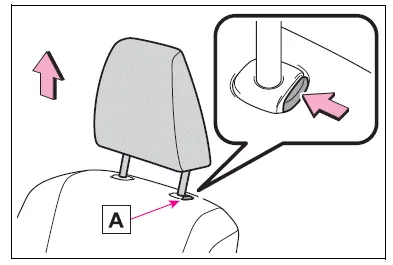Toyota Corolla (E210) 2019-2025 Owners Manual / Before driving / Adjusting the seats / Head restraints
Toyota Corolla (E210): Head restraints
Head restraints are provided for all seats.
WARNING
■Head restraint precautions
Observe the following precautions regarding the head restraints.
Failure to do so may result in death or serious injury.
- Use the head restraints designed for each respective seat.
- Adjust the head restraints to the correct position at all times.
- After adjusting the head restraints, push down on them and make sure they are locked in position.
- Do not drive with the head restraints removed.
Adjusting a head restraint
■ Front seats

- Up
Pull the head restraints up. - Down
Push the head restraint down while pressing the lock release button A.
■ Rear seats
Head restraints cannot be adjusted or removed.
■Adjusting the height of the head restraints (front seats)
Make sure that the head restraints are adjusted so that the center of the head restraint is closest to the top of your ears.

Removing the head restraints
■ Front seats
Pull the head restraint up while pressing the lock release button A.

■ Rear seats
Head restraints cannot be adjusted or removed.
Installing the head restraints
■ Front seats
Align the head restraint with the installation holes and push it down to the lock position.
Press and hold the lock release button A when lowering the head restraint.

■ Rear seats
Head restraints cannot be adjusted or removed.
Other materials:
Inspection procedure
Hint:
start the inspection from step 1 in case of using the hand–held tester and start
from step 2 in case of not
using the hand–held tester.
1 Read value of hand–held tester(front speed sensor)
Select the datalist mode on the hand–held tester.
check that there is no differe ...
Warning lights and indicators
The warning lights and indicators on the instrument cluster,
center panel, overhead console and outside rear view mirrors inform the driver
of the status of the vehicle's various systems.
Warning lights and indicators displayed on the instrument
cluster
For the purpose of explanation, the followin ...
Basic inspection
Resistance measuring condition of electronic parts
unless stated, all resistance is measured at an ambient
temperature of 20 c (68 °F). As the resistance
may be outside the specifications if measured at high temperatures
immediately after
the vehicle has been running, measu ...


